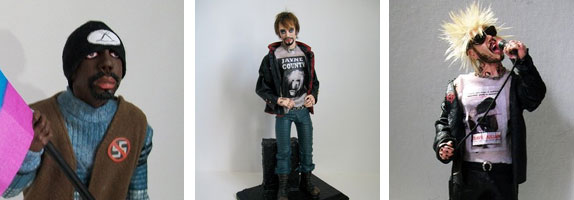
Luke Velazquez on the singular experience of the queer punk scene, reflected in the work of sculptor Fernando Carpaneda
In our society, people are expected to behave in a certain way. To grow up, go to school, work a soulless dead end job, squirt out a few kids for the good of the commonwealth and do so without question. But occasionally, a person, or a group of people, comes along and they pursue their own path – a path that draws the ire and the contempt of the masses, but also spawns jealousy and the desire for their lives to be so free of monotony. Eventually, these people find one another, and their numbers grow, turning into a community with its own set of ideals, values, beliefs and aesthetics. They turn their backs on the masses, which in turn, peek over their shoulders to catch a glimpse of their lives, and their ways, to see why they are so content to be living a life so different from all others.
Whether you’re a queer or a punk, it means that you’ve got an attitude that the masses disagree with, and that you’ve dedicated yourself to a life of constant scrutiny. But to be a queer punk means that even among your own kind, you can still be an outsider. As lines are drawn and ideas are solidified, people have been pushed out of either community. This happens for the sake of preserving everyone’s best interests, or to keep the scene ‘pure’. Despite this, however, we exist, and we walk the line between fringe groups, too gay to be a punk, too hardcore to be a fag. And even though discrimination happens, for every hater you’ll meet ten times as many supporters in the gay community or in the punk scene. No other social circles out there can say that they are as open minded or accepting as ours. At the end of the day, it doesn’t matter what side you stand on, as long as you’re proud of who you are.
The works of Fernando Carpaneda show us a world of carnal desire, where the line between queer and punk is non-existent. Here, we see men unafraid of embracing their libido and all the dark alleyways it may take them down. His depicts his punks, stripped of their studded leather jackets, tight pants and chains, bared naked to the world, so that we can see who they really are. This is done, less as an act of sexual depravity, and more an expression of their overt and undeniable masculinity. Fernando’s works serve as a reminder that sexuality is a pillar on which both the gay scene and the punk scene have drawn on for support, and despite all the differences, the two scenes will constantly look to one another for inspiration. So whether you’re gay, straight, bi or otherwise, a punk rocker or a scene queen: stay proud, stay true, stay queer.
—–
Fernando Carpaneda:Queer.Punk.
Open daily, June 26th to July 2nd,1-6pm
The Leslie/Lohman Basement Annex
127-B Prince Street, New York City, NY 10012
Carpaneda’s sculptures reflect the extraordinary side of the human element. Hustlers, rent boys, punk rockers, unknown artists, junkies, thieves and outcasts are recreated to the minutest detail in clay. Parts of the artist’s own clothing are hand tailored into miniature wardrobes. In the style of the17th-century paintings of secular subjects, human hair and modern day relics are incorporated into each piece to reflect a sense of capturing a moment in time.The artist takes his inspiration from the urban element and uses the language of the street along with his own experiences with drugs and street life. His bold artistic statements as a gay activist are painstakingly expressed through this controversial work. Often sexual in nature, his ‘in your face’ approach to the acceptance of gay sexuality and the Queer Punk lifestyle are recreated to provoke and inspire the observer.
Further Resources:
